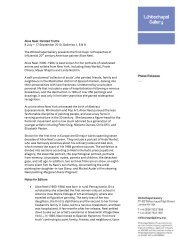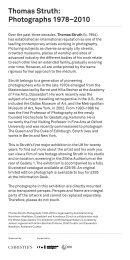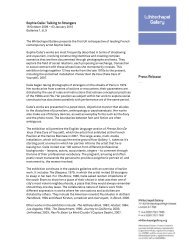For the happy man! - Collected writings DEPRESSION: Ed Atkins
For the happy man! - Collected writings DEPRESSION: Ed Atkins
For the happy man! - Collected writings DEPRESSION: Ed Atkins
You also want an ePaper? Increase the reach of your titles
YUMPU automatically turns print PDFs into web optimized ePapers that Google loves.
Or <strong>the</strong>re’s nowadays, by which time she lives in <strong>the</strong><br />
void, of course, glancing occasionally at her hands as if in an<br />
attempt to catch <strong>the</strong>m off guard. Her hands were lucid where<br />
her mind was not. A dreadful thought, that: lucid hands! That<br />
we understand anatomists as describing most of <strong>the</strong> cortex –<br />
which is a slice of <strong>the</strong> brain, of course – <strong>the</strong> part <strong>the</strong>y call <strong>the</strong><br />
ISOCORTEX in most, and something else entirely in HER – as<br />
having six layers, but not all layers are apparent in all areas, and<br />
even when a layer is present, its thickness and cellular organization<br />
may vary. Several anatomists – though very few I’ve ever<br />
met – have constructed maps of cortical areas on <strong>the</strong> basis of<br />
variations in <strong>the</strong> appearance of <strong>the</strong> layers as seen with a cheap<br />
plastic microscope. One of <strong>the</strong> most widely used schemes came<br />
from Brod<strong>man</strong>n, who split <strong>the</strong> cortex into fifty-one different<br />
areas and assigned each a number (some anatomists have<br />
since subdivided <strong>man</strong>y of <strong>the</strong> Brod<strong>man</strong>n areas). <strong>For</strong> example,<br />
Brod<strong>man</strong>n area one is <strong>the</strong> primary somatosensory cortex,<br />
Brod<strong>man</strong>n area seventeen is <strong>the</strong> primary visual cortex, and<br />
Brod<strong>man</strong>n area twenty-five is <strong>the</strong> anterior cingulate cortex.<br />
Something like that. Brod<strong>man</strong>n area twenty-three is, I think,<br />
entirely missing in our example. Which might go some way to<br />
explaining <strong>the</strong> lucidity of hands – in her case. As discrete from<br />
<strong>the</strong> lucidity of <strong>the</strong> mind. The absence of area twenty-three being<br />
connected to certain cases of Cotard’s syndrome, also – <strong>the</strong><br />
syndrome being a rare neuropsychiatric disorder (or genuinely<br />
neurological, in <strong>the</strong> case of a lady from Tarzana) in which<br />
people hold a delusional belief that <strong>the</strong>y are dead (ei<strong>the</strong>r figuratively<br />
or literally), do not exist, are putrefying, or have lost<br />
<strong>the</strong>ir blood or internal organs. In rare instances, it can include<br />
delusions of immortality.<br />
Or <strong>the</strong> recollection of that Peter Lorre vehicle – ‘The<br />
Hands of Orlac’, I think it was. Or perhaps it was simply called,<br />
‘MAD LOVE’! In which he plays an insane surgeon who transplants<br />
<strong>the</strong> hands of an executed murderer – a notorious stran-
















